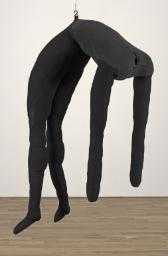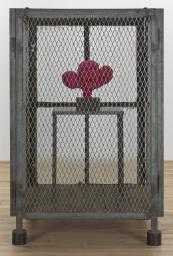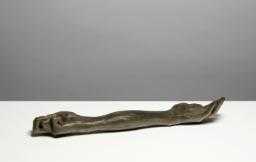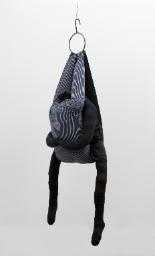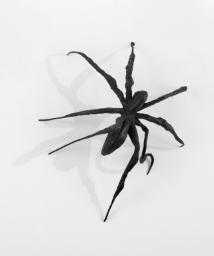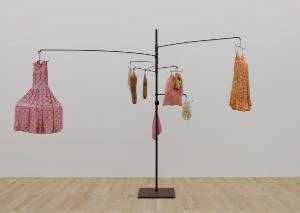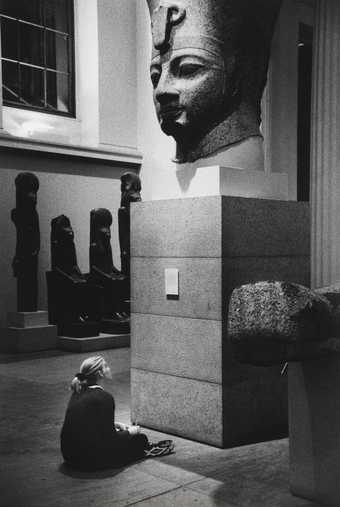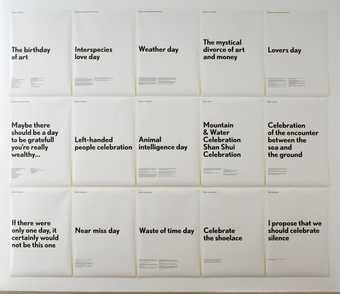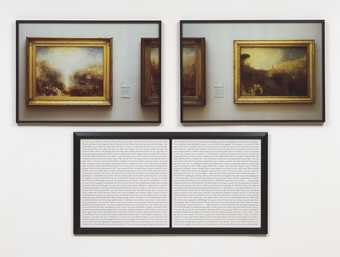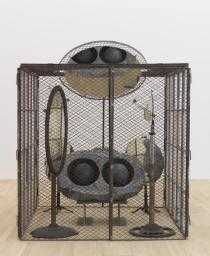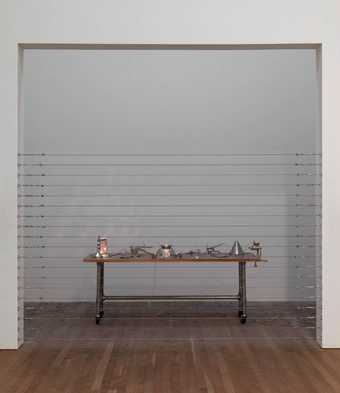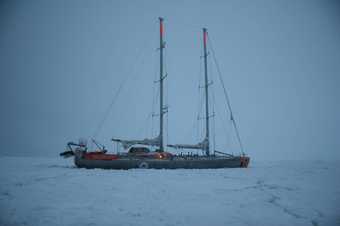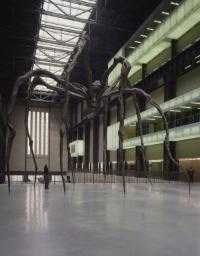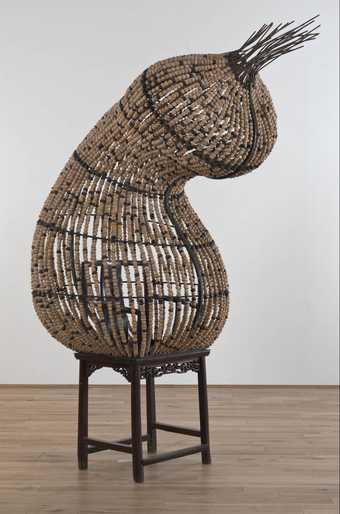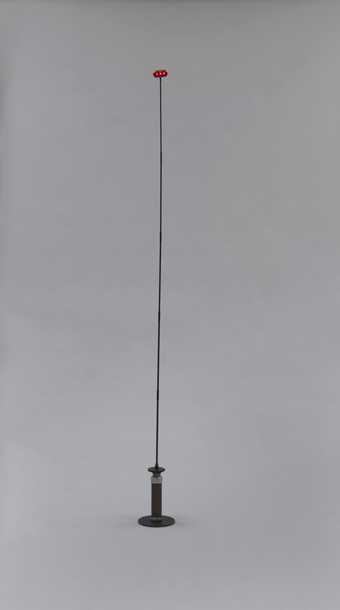In Tate Modern
- Artist
- Yto Barrada born 1971
- Medium
- Aluminium, steel, paint and coloured light bulbs
- Dimensions
- Object: 2540 × 1550 × 510 mm
- Collection
- Tate
- Acquisition
- Purchased 2011
- Reference
- T13281
Summary
Palm Sign is a large painted metal sculpture of a palm tree, illuminated with coloured light bulbs. The work is in less than perfect condition, with scratches in the paint and empty bulb sockets, giving it the appearance of an old or neglected object; however it has been specifically produced by the artist to look this way. The colour of the palm tree (cream) is the colour of the taxi cabs in Barrada’s home town of Tangiers in Morocco. Palm Sign has been made in an edition of three plus one artist’s proof. Tate’s version is number one in the edition; the other versions are painted different colours corresponding to the taxis in other Moroccan cities.
This work was first shown in Beirut in an exhibition of Barrada’s work at Galerie Sfeir-Semler in 2010 entitled ‘Play’. The show brought together a number of pieces in which she explored her concerns about the gentrification and urban development of Morocco. The title of the exhibition characterises Barrada’s combination of serious issues with playfulness and wit. Often used in marketing campaigns abut Morocco, the palm tree has become an important image in Barrada’s recent practice, as well as an icon of local exoticism. It is thus ironic that the tree is not native to Morocco and was originally imported. The worn and decaying appearance of Palm Sign evokes formerly popular holiday destinations now left in disrepair, highlighting the cyclical nature of modernisation and decay.
Palm Sign is part of a larger body of work by Barrada in which she employs the symbol of the palm tree, including Palm Project, initiated at the 3rd Marrakech Biennale in 2009. Here the artist organised a large picnic to discuss the rapid modernisation of Morocco. The project examined the marketing campaigns used to promote ‘contemporary’ Morocco and the potential damage to the region’s precarious eco-system caused by the development of luxury hotels and golf courses. The paradoxes inherent in such campaigns were explored by Barrada in a text distributed at the event entitled ‘A Modest Proposal to Modernise Morocco and Maximise its Resources and Efficiency’. The text is signed by Yahya Sari, which is the Arabic name for Irish satirist Jonathan Swift (1667–1745), who wrote the satirical essay ‘A Modern Proposal’ in 1729. With similar mocking humour, Barrada’s text outlines some of the hypocrises of such modernisation:
With admirable foresight, our Government is working to realise a grand goal set ten years ago: to increase tourism from our current two million foreign visitors per year to 10 million. But where will we put them? The answer: a new generation of coastal resorts and real estate developments, where vacant lots and abandoned forests are transformed into villas and hotels, swimming pools and golf courses; where scrappy farm land and useless coastal wetlands become tidy shopping areas served by high speed rail lines, and seaside corniches are lined with our world-famous neatly trimmed palm trees.
(Palm Project, artist’s edition, published by Yto Barrada, Rabat, Morocco 2009.)
The text goes on to discuss the differences and inequalities between the indigenous people of Morocco – the ‘Moor’ – and first generation Moroccans with French heritage, whom the text brands as ‘educated’. It ironically outlines a plan to slowly eradicate the ‘Moor’ people, while carefully selecting the ones that should remain to ‘dig our ditches, make our beds, shine our shoes, repair our cars and build our villas’ (Palm Project, artist’s edition, published by Yto Barrada, Rabat, Morocco 2009).
Further reading
Hossein Amirsadeghi (ed.), Newvision: Arab Contemporary Art in the 21st Century, London 2009, pp.98–101.
Mark Godfrey, T.J. Demos, Eyal Weizman, Ayesha Hameed, ‘Rights of Passage’, Tate Etc., no.19, Summer 2010, pp.60–9.
Abdellah Karroum, ‘Yto Barrada: A Modest Proposal’, Nafas: Online Art Magazine, February 2010, http://universes-in-universe.org/eng/nafas/articles/2010/yto_barrada, accessed 30 October 2010.
Kyla McDonald
October 2010
Does this text contain inaccurate information or language that you feel we should improve or change? We would like to hear from you.
Display caption
Palm Sign is part of a larger body of work in which Barrada explores how the symbol of the palm tree is used in marketing campaigns to promote ‘contemporary’ Morocco. The worn and decaying appearance of Palm Sign evokes formerly popular holiday destinations now left in disrepair, highlighting the cyclical nature of modernisation and decay. Palm Sign reflects Barrada’s consistent interest in analogue and readymade materials. The funfair aesthetic wryly speaks to the way artificial landscapes are quickly transplanting indigenous ecologies in Morocco, and more broadly, around the world.
Gallery label, November 2022
Does this text contain inaccurate information or language that you feel we should improve or change? We would like to hear from you.
Explore
- abstraction(8,615)
-
- from recognisable sources(3,634)
-
- landscape(1,191)
- formal qualities(12,454)
-
- light(150)
- recreational activities(2,836)
-
- travel / tourism(803)
- heating and lighting(846)
-
- lightbulb(39)
- cities, towns, villages (non-UK)(13,323)
-
- Tanger(1)
- Morocco(41)
- lifestyle and culture(10,247)
-
- cultural identity(7,943)
You might like
-
Louise Bourgeois Single II
1996 -
Louise Bourgeois Cell XIV (Portrait)
2000 -
Louise Bourgeois Give or Take
2002 -
Louise Bourgeois Couple I
1996 -
Louise Bourgeois Spider I
1995 -
Louise Bourgeois Untitled
1996 -
Elliot Erwitt The British Museum, London
1995 -
Pierre Huyghe One Year Celebration
2006 -
Sophie Calle Purloined (Turner)
1998–2013 -
Louise Bourgeois Cell (Eyes and Mirrors)
1989–93 -
Mona Hatoum Home
1999 -
Pierre Huyghe A Journey that wasn’t
2005 -
Louise Bourgeois Maman
1999 -
Chen Zhen Cocon du Vide
2000 -
Takis Signal
2000


